6-6-10
Younger than Springtime: South Pacific Soars at the Ahmanson
By Diane Sippl
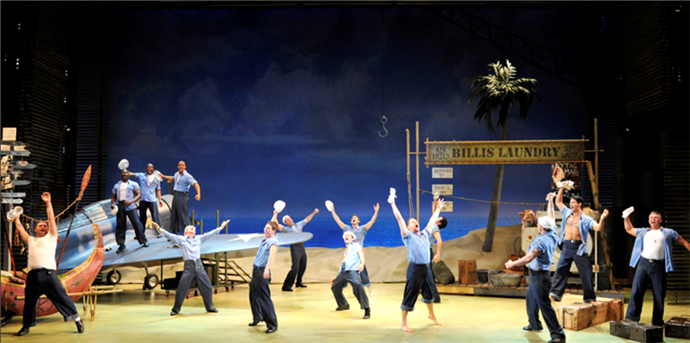
South Pacific as produced by the Lincoln Center Theater and directed by Bartlett Sher at the Ahmanson Theatre in Los Angeles, 2010
Whatever
the reason, people simply had to see, and hear, the story of Nellie and De
Becque. The scalpers had a field
day. It has been estimated that the
audience at a given performance has actually paid about four times the box
office price. Tickets were given as
bribes — one man known to this correspondent offered his income tax collector
three pairs, for which he had paid a tidy hundred dollars apiece. (Whether or not the outraged collector
accepted them I wouldn’t know.) Possessing tickets to South Pacific had actually became a mark of social distinction. Persons who hadn’t seen the show begged
ticket stubs from their more fortunate neighbors in order to deposit them
negligently on the mantelpiece for the edification of dinner guests.
What American musical has not projected a symbolic, mystical place that offers in its embrace a release from taboos, a liberated spirit, a healed heart? The extended imagination and the yearning for communion, whether personal or social, are quests at the core of the lyrical form. “Some Enchanted Evening,” “Younger than Springtime,” and “Bali Ha’i” have been popular American standards for half a century and more. Amazingly, it has taken all that time to revive their original ambiance, animated with laughter and charm, on the Broadway stage. That it happened in 2008 with utter respect for the art and stagecraft of South Pacific as it originally appeared, and that the Lincoln Center Theater production so vividly upholds its source as Bartlett Sher directs the play’s tour to Los Angeles at the Ahmanson Theatre in the summer of 2010, is a delightful surprise.
With previews spanning Memorial
Day weekend and playing right through the 4th of July (‘til the 17th),
and with an opening night red carpet for Roslynd Lowe Mass, Shirley Jones, and
Barbara Luna of the original Broadway cast in 1949, and Mitzi Gaynor, John
Kerr, and France Nuyen of the 1958 film adaptation, South Pacific may strike some as that nostalgic journey to overseas
Americana where the waves of romance never end.
A younger generation may find the play “as corny as
Others will find, lurking behind the
bleeding-heart liberal song, “You’ve Got to Be Carefully Taught” and the exotic
“Bali Ha’i,” not so much a critique of a pre-Civil Rights Era (in which Juanita
Hall, the play’s original Bloody Mary, was denied hotels when she toured with
the show) but a commercially entertaining exploitation of the contradictions of
racism and popular culture alike. For example, at the outset of the South Pacific project, the Rodgers and
Hammerstein team, seemingly peaking in 1949 with
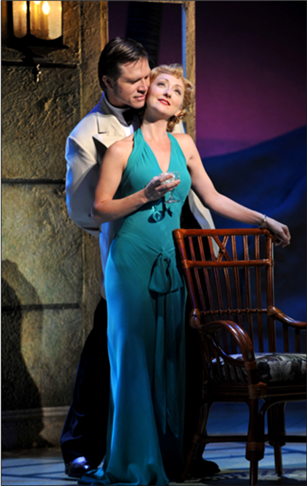
I wish I could tell you about the South Pacific. The way it actually was: the endless ocean. The infinite specks of corals we called islands. Coconut palms nodding gracefully toward the ocean. Reefs upon which waves broke into spray, and inner lagoons, lovely beyond description. I wish I could tell you about the sweating jungle, the full moon rising behind the volcanoes, and the waiting. The waiting. The timeless, repetitive waiting.
But whenever I start to talk about the South Pacific, people intervene. I try to tell somebody what the steaming Hebrides were like, and first thing you know, I'm telling about the old Tonkinese woman who used to sell human heads. As souvenirs. For fifty dollars!
James Michener, Tales of the South Pacific, 1946
Rod Gilfry and Carmen Cusak as French planter Emile de Becque and Nurse Nellie Forbush in the Lincoln Center Theater production at the Ahmanson Theatre in Los Angeles, May 27-July 17, 2010
Setting aside the differences (that might be acutely noted) between a Puccini opera cloaked in the Japanese culture of 1890s Nagasaki and a Broadway musical evoking the Tonkinese and Polynesian inhabitants of Guadalcanal in 1942, Rodgers and Hammerstein saw the themes of the American encounter with the “strangers” in each setting as too much alike, and perhaps they were right, given that the point of view remains somewhat the same. Had America’s perception of the “yellow race” changed so much in its monolithic branding and pan-Asian abuse (both state-side and abroad) between the “Progressive Era” of Hearst’s yellow journalism as the country took over the Philippines and other islands in the Spanish American War and the U.S. incarceration of Japanese Americans half a century later during World War II? Indeed, perhaps the culture wasn’t ready for “another” taste of the Orient, much as it needed to become acquainted with the multiplicity of distinct cultures that struggled to inhabit the many places west and south of the American mainland and even the cities, towns, and farms within it. And yet James A. Michener, a teacher and textbook editor who’d become a first-time author in the Navy, had just won the Pulitzer Prize for Tales of the South Pacific in 1947.
When Oscar Hammerstein set about adapting it for his libretto the following year, he drew primarily from three of Michener’s nineteen separate sketches: “Fo’ Dolla’,” which gave him the characters of Bloody Mary, a Tonkinese woman who lived and worked on the island, her daughter Liat, and Lt. Joe Cable, a naval officer from Philadelphia who had gone to college at Princeton; “Our Heroine,” the story of nurse Nellie Forbush from Otolousa, Arkansas and a Frenchman, Emile De Becque, who owned a vast cacao and coconut plantation; and “A Boar’s Tooth,” a sketch of Luther Billis, an American Navy wheeler-dealer who traded anything he could get his hands on, much of it illicit goods. Though “Fo’Dolla’” was what caught the eye of Rodgers and Hammerstein and is three times as long as the other tales, the central character of the play became Nellie in “Our Heroine”; the main thrust of the drama is hers, and the “conventional dither” of her heart is the conflict with which we become most familiar, through the play’s action and songs alike.
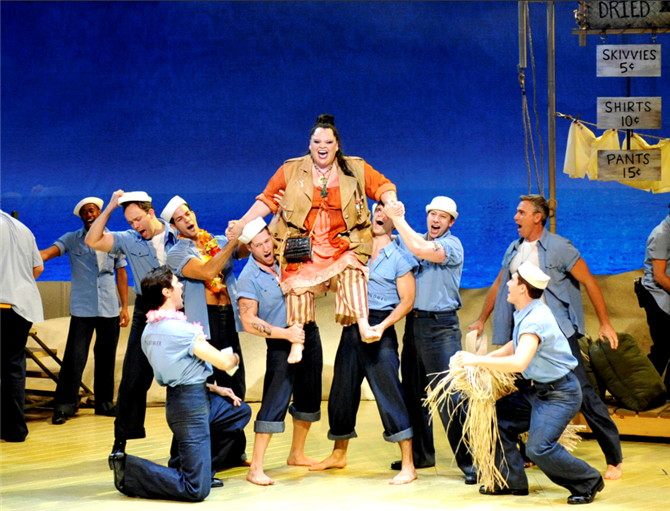
Keala Settle as Bloody Mary with the male ensemble at the Ahmanson Theatre in Los Angeles, May 27-July 17, 2010
If the
main love story is serious, the secondary romance is usually employed to
provide comic relief — such as Ado Annie and Will Parker in
Musical Stages: An Autobiography, Richard Rodgers, 1975
Michener offers an interesting first-hand perspective on the lives of the women on the island of Guadalcanal during the year of 1942, not only of a cadre of American naval nurses, but of Tonkinese women who had been imported by the French as indentured servants on the plantations, Javanese women who came from and returned to Indonesia, and Polynesians, all of whom needed to be protected from men — according to Michener, not from the Frenchmen who owned the plantations and took it upon themselves to sequester the women and girls safely on a more remote island and procure food for them, but from the Japanese (should they invade) and the American soldiers alike, both groups known to assault and abuse the women and girls.
Laying this dangerous ground for the reader and then “pollinating” it with the most diversely luxuriant natural life one can read on the pages of a book, Michener sets his conflict: soldiers’ hormones running rampant in a torrid climate among young native and American females across jungles in which every flower is an aphrodisiac carried on the sea breeze. Nellie herself is swept up in passion, engaged to a boy back home, “proposing” to a Navy officer in her own tipsy flirtation, and then falling for the love of her life, Emile de Becque. Because the racial tension in the play all but obscures the gender issues even though they are part and parcel of the social and cultural clashes, and because Michener’s story dwells on Nellie’s point of view, it’s interesting to look at all the “firsts” he shows a young woman like Nellie experiencing at the end of World War II, given that the narrative turf of war stories forever favors men for its protagonists.
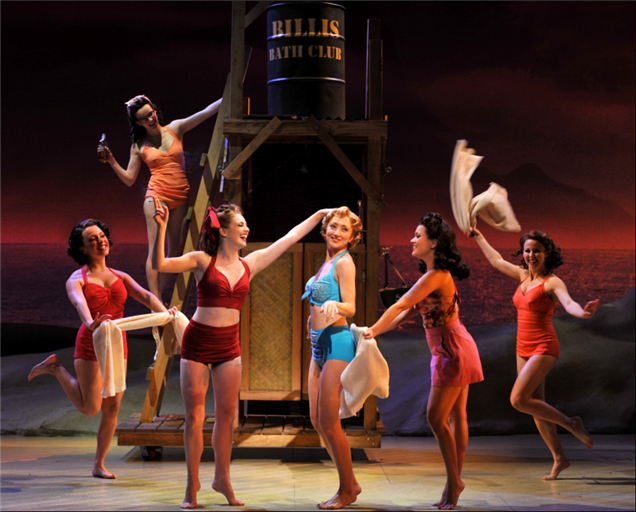
Carmen Cusack with the female ensemble at the Ahmanson Theatre in Los Angeles, May 27-July 17, 2010
One decision we made early in the preparation of South Pacific was that we would not have the kind of choreography to which audiences had been accustomed in previous Rodgers and Hammerstein musicals. We had two strong, dramatic stories, and we didn’t need extended dance routines to flesh them out in any way. With his tremendous gift for staging, Josh managed individuals and groups so well that there wasn’t a static moment. He brought a feeling of movement to the entire production which brilliantly disguised the fact that its dancing was minimal and basically formless.
Musical Stages: An Autobiography, Richard Rodgers, 1975
After the first time she hears of the death of a soldier she knew — the one to whom she had “proposed” — Nellie is physically sick for days, only to discover that he’s been saved; but then it’s also her first brush with guilt regarding a man with whom she’s been intimate, even if they were only necking in the back of a jeep. She has no real feelings for him, whether he’s risking his life for his country or not, and she’s ashamed. The humiliation of her out-of-gender behavior in this strange new place is supplanted by the thrill of her very first plane ride, over twin volcano peaks rising in the Pacific, after which she lands feeling like “Cinderella stepping from the pumpkin.”
At an evening dinner party, the vista from De Becque’s veranda offers Nellie her first sensation of an overwhelmingly florid garden, with azaleas, hibiscus, hydrangeas, bougainvilleas, red flaming bushes and frangipani trees that host birds of every hue and size — green, red, purple and yellow lorikeets along with swallows, hawks, and sea birds — but none to match the myriad colors of the cacao grove, in bright sunlight, a hall of mirrors with the iridescent leaves, the pods on any one tree ranging so much in color that they appear to be the “chameleons of the jungle.”
Nellie’s tour also causes her to confront for the first time her own social position regarding people of color when she discovers De Becque has eight daughters by four other women, two of the mothers Javanese, one Tonkinese, and one Polynesian — a “nigger” in Nellie’s “tutored mind.” Marrying De Becque would mean raising four little “niggers.” Yet what makes it impossible to reject this idea is another first for Nellie: she becomes the victim of an attempted gang rape by American soldiers until De Becque, swinging his brass pipe on a knotted chain, defends her and they escape. He is fearless and he is powerful: however, he has not married any of the four island women, just as Nellie is not entering into a mixed-race marriage. (That would have to wait for Rodgers and Hammerstein’s next play, The King and I.)
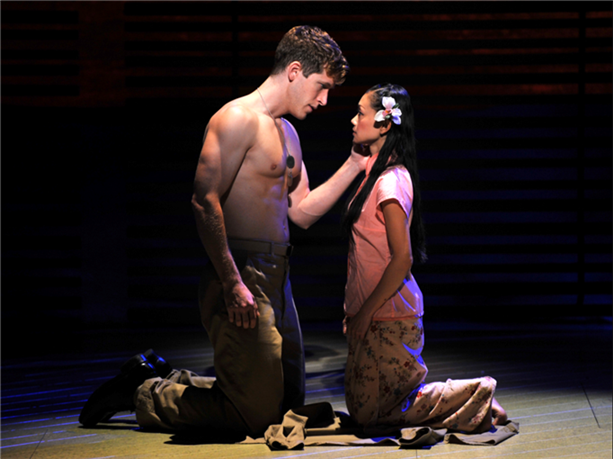
Anderson Davis as Lt. Joe Cable and Sumie Maeda as Liat at the Ahmanson Theatre in Los Angeles, May 27-July 17, 2010
…For months Oscar and I had been talking about a song for Bloody Mary which would evoke the exotic, mystical powers of a South Seas island. I knew that melody would have to possess an Oriental, languorous quality, that it would have to be suitable for a contralto voice, and even that the title was going to be “Bali Ha’i.” Therefore, as soon as I read the words, I could hear the music to go with them. If you know your trade, the actual writing should never take long.
Musical Stages: An Autobiography, Richard Rodgers, 1975
By 1949 South Pacific, a paean to cross-race and cross-cultural curiosity, compassion, and whole-hearted bonding in word and deed, opened in New York at the Majestic Theatre and swept the prizes for which it was eligible, winning the New York Drama Critics’ Circle award for Best Musical Play in 1949-50, eight Tony and nine Donaldson awards, and even the Pulitzer Prize for Drama in 1950, a first for musical theatre, in a season when what “also ran” were plays by Arthur Miller, Tennessee Williams, Sidney Kingsley, Clifford Odets, and Jean-Paul Sartre. South Pacific then played for 1,925 performances (nearly five years) on a Broadway that by that time offered many imitations of the Rodgers and Hammerstein brand of musical — one written with down-to-earth dialogue, scored to present its diverse characters, and choreographed thematically.
A musical that was more drama than comedy, dredging up the sobering topics of war, racial divides and cultural identity; a team that had become known for introducing classical ballet into its imaginatively staged social-problem repertoire — how did Rodgers and Hammerstein resolve two challenges they identified as levity and grace in a story of Seabees and military nurses? One way was to come up with a female lead who, for the first time, was not a soprano but a “belt” who could hold her own, both acting and singing, in a comic role within a tragic play. Nellie was one of their innovations that season, expected to carry the score of the play with a “Broadway” voice, and Mary Martin did just that.
Then to bring both élan and gravitas to the show, they signed Ezio Pinza, the highly touted Metropolitan Opera singer, in his first role in a popular show, violating the tracks they themselves had laid down for bypassing the star system in casting but at the same time breaking with the youth-oriented tradition of musicals by casting an “older” male as the lead. Once Pinza took on the role of the Frenchman De Becque vis-à-vis Mary Martin, the concern (beyond his heavily Italian-accented English) was how to pair her husky voice with his basso cantante. The answer was to avoid pairing belt with bravura by letting them sing alternately instead of in duets. After all, it made the clash of cultures that much more audible and visible. To boot, “Twin Soliloquies,” interspersed between Nellie’s “A Cockeyed Optimist” and De Becque’s “Some Enchanted Evening,” was added to build tension that climaxed in the orchestra, not the voices, in a kind of instrumental opera. Another first was to use song as a precursor to action —even to the idea of action, such as the way that the forlornly slow, sad waltz, “This Nearly Was Mine” triggers De Becque’s decision to go accompany Lt. Cable on his deadly mission.
Rodgers and Hammerstein had turned the stereotyped formula of the Broadway musical comedy into an art form that revolutionized the popular musical theatre... they had made an organic work of lyrical art out of a familiar entertainment medium. South Pacific was a work in their own tradition (of) integrated musical plays in which music, story, dancing and décor expressed a single point of view. In the circumstances, no one doubted that South Pacific was going to be a piece of genuine stage literature.
All of these characters contain a measure of humility, sympathy, and taste. They are decent people: they have the forbearance of people who respect the rights of others. They have conscience.
Brooks
Atkinson in The Tale of the South Pacific,
Ed. Thana Skouras, 1958
May 27-July 17, 2010
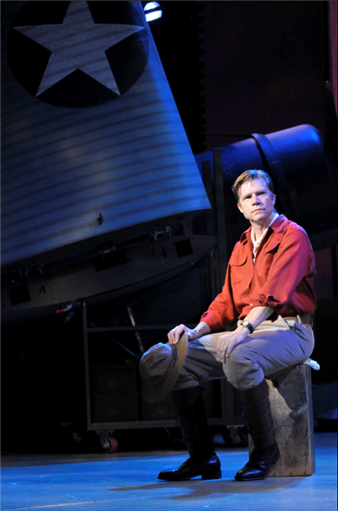
Yet the R&H team had set up for itself another obstacle: for the first time, it had now created two “heavy” couples as the first and second leads, whereas the formulae for the successful partners had been a serious main couple and a lighter, more amusing and distracting second couple. Therefore “A Cock-Eyed Optimist” and “Honey Bun” were written precisely for Nellie to pepper the play with some humor beside the deep and solemn relationships, whether her own or that of the second couple, Lt. Cable and the young islander Liat. Furthermore, though Hammerstein as a lyricist strived to use rhymes sparingly, Nellie’s song, “A Wonderful Guy” was ingeniously packed with interior rhymes and alliteration:
I expect everyone,
Of my crowd to make fun,
Of my proud protestations of faith and romance.
And they’ll say I’m naïve,
As a babe to believe,
Ev’ry fable I hear from a person in pants!
Fearlessly I’ll face them and argue their doubts away
Loudly I’ll sing about flowers in spring;
Flatly I’ll stand on my little flat feet and say
Love is a grand and a beautiful thing…
…I’m as trite and as gay
As a daisy in May
A cliché coming true!
I’m bromidic and bright
As a moon-happy night
Pouring light on the dew!
Then five consecutive repetitions of the declaration “I’m in love” to end the song made Nellie look more than “corny as Kansas in August”; Hammerstein’s lyrics were charting the pivotal moment in which the self-proclaimed “hick” from provincial Arkansas reached a point of no return in her heart despite the news to come that challenged all her “moral” upbringing. Her seemingly ridiculous proclamation, deceivingly simple, showcasing Nellie to be as socially naïve as she was unabashedly enamored, was, in many ways, the cornerstone of the play: the spirit of the musical’s conviction sailing on the breeze of a song.
A new stride in staging the singing in the play was to use the ensemble not as a unified chorus but as separate individuals who each spoke distinct lines of dialogue. In a song such as “There Is Nothin’ Like a Dame,” each Seabee sang his own lines alternating with the others’. The only portion of the song they sang as a chorus was the refrain.
One more consideration was choreography. For the first time, Rodgers and Hammerstein defied their own innovation regarding the use of dance and dispensed with it entirely. South Pacific did make use of impeccable stage blocking implemented by the play’s director, Josh Logan, to convey the feeling of spontaneous movement and amateur performances. It was Oscar Hammerstein’s idea to incorporate a simple soft-shoe hitch-kick and scissors into the show-within-a-show, and Mary Martin, who was cast as Nellie and had once taught tap dance, choreographed another routine. Nonetheless, the acrobatics, broad gestures, and skits of “Bloody Mary” and “There’s Nothing Like a Dame” as well as the Thanksgiving variety show were as carefully designed by Logan as Liat’s moving hands during the song, “Happy Talk.”
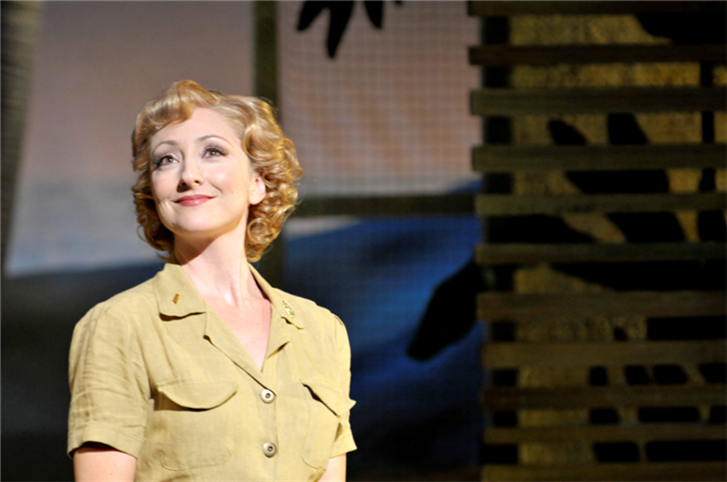
May 27-July 17, 2010
Nellie Forbush… wanted to see the world… she wanted to talk with strange people, to find out how they lived, and what they dreamed about, interesting little things that she could treasure as experience.
Hers was the heart-hunger that has sent people of all ages in search of new thoughts and deeper perceptions… (She was) longing for ideas and experiences… a realist, but of that high order which includes symbolism and some things just beyond the reach of pure intelligence.
But what of that fluid ambiance of the South Pacific itself, in which the sky meets the sea and lovers find their dreams? How was this very issue-driven, earthy play to capture that breeze of romance? As in their previous production, Allegro, which resembled a dance with dialogue rather than a play with songs, Rodgers and Hammerstein used the technique of quick-change exits of one group of performers as the next group took up the stage. Props and sets were ingeniously moved on and off the stage by the actors in front of the same backdrop (or occasionally a scrim) and within the same frame so as to allow the scenes to dissolve seamlessly one into the next.
Furthermore, the score of South Pacific was comprised of more basic musical numbers than any of R&H’s previous plays and almost twice as many music cues from the orchestra, allowing for a nearly continuous murmur of music, even under the dialogue or to accompany pantomime, causing the stage actions to appear more plausible and the speech to melt easily into song.
As for the writing, Hammerstein had launched a new way of working with a composer for South Pacific. He wrote the lyrics first and then handed them over to Rodgers to be set to music. This method freed Hammerstein to experiment with new rhythms and forms within the lyrics themselves while allowing them to stem from the emotions he visualized for the characters of his book. Writing his lyrics in the language of spoken dialogue also helped to ease the transition from speech into song throughout the play.
South Pacific begins and ends on a quiet note: the intimate bliss of familial harmony, though at first it is not configured as such. That will be the task of the dramaturgy with all its musical pull. The current Los Angeles production at the Ahmanson as directed by Bartlett Sher provides all the mystique of its predecessors with staging that is lean, elegant, and ethereal. Once designer Michael Yeargan’s giant screen of Michener’s handwritten pages (reprised later in the play with a map of the region) gives way to his bamboo-slat windows on the deep blue sky and sea, our exotic voyeur’s point of view, framed with ferns and palms, is lit with the light of romance by Donald Holder.

in the Lincoln Center Theater production at the Ahmanson Theatre in Los Angeles, May 27-July 17, 2010
In South Pacific the device of changing the light and texture… for a musical number is a very important contribution. It is a kind of subtle acknowledgment that the literal reality of dialogue will be suspended for a moment while we pretend that people express their thoughts and feelings in song. It helps our imagination to find the poetry that sings inside us at certain times but which our fumbling prose does not express.
Nellie (Carmen Cusack) is conspicuously the only blonde in a cohort of brunette nurses, and in Catherine Zuber’s costumes she shines in aquamarine gowns and swimsuit among the flame-colored togs of the other nurses. To see them all barefoot reminds the audience how women looked before six-inch heels became the vogue — more than a full head shorter than their men! And while Liat (Sumie Maeda) is also a good foot thinner all-around than her tall and brawny lover Lt. Cable (Anderson Davis), Rod Gilfry as the male lead looks a good ten years younger on all counts than his late-middle-aged De Becque.
Having said this, the voices soar, Gilfry’s as the opera baritone that he is and Cusack’s as the folksy soprano that she is. Despite her pithy southern drawl and her sputtering trill in many of her songs, she has not the brassy “bass” that Mary Martin jokingly called her own voice. Anderson Davis is perhaps the biggest surprise: his first sung lines, the refrain of “Bali Ha’i,” begun backstage with his back to the audience, thrill with the eerie echo of Keala Settle’s alto as Bloody Mary. Their voices, both erotically androgynous, color the tone of the play beyond words in another example, albeit one heretofore unmentioned, of Rodgers and Hammerstein’s divided duets.
Another thrill is the cumulative excitement of “There’s Nothin’ Like a Dame.” Setting aside the ingenuity of the careful blocking and gymnastics of frustrated bodies and the alternating vocal lines among the male ensemble, their’s nothin’ like a male when they sing united in the boisterous, consolidated testosterone of one voice for the chorus. They out-do the choral work of the nurses, but of course, there are three times as many of them on the stage. Nonetheless, they are three times as impacting and resonant, especially given that the weak-kneed soft-shoe dancing of the “dames” in the staged variety show registers as a missed opportunity for more skilled dancing, just as the routine in drag lacks a bit of luster, risk, and humor for a 2010 audience. Matthew Saldivar as Luther Billis carries the acting on his lively shoulders, injecting a zest into the play more convincingly than Keala Settle’s inherently hammy Bloody Mary. Still, disappointments are negligible in a meticulous production all-around, one in which the elocution of the colloquial and culturally-inflected dialogue is always crystal-clear and persuasive and the singing and acting generally pitch-perfect.
From whatever standpoint, the Lincoln Center Theater production of South Pacific at the Ahmanson in Los Angeles is impeccably staged and performed, preserved and resurrected in all its splendor and allure. Unfortunately, the themes of war and its incumbent issues of cultural difference are as relevant today as they were in 1942 when the play was set and in 1949 when it opened on Broadway and in 2008 when it was revived there. And one more thing hasn’t changed: South Pacific might be one aspect of American pop culture at its best, but at $50 a “pop” for Memorial Day weekend previews and $20-120 for regular-price tickets, this gem of live theatre may hardly reach the masses. Go early for cheap “rush” tickets, but GO!
South Pacific
Book: Oscar Hammerstein II and Joshua Logan; Adapted from: Tales of the South Pacific, James A. Michener; Music: Richard Rodgers; Lyrics: Oscar Hammerstein II; Director: Bartlett Sher; Musical Staging: Christopher Gattelli; Music Director: Ted Sperling; Music Conductor: Lawrence Goldberg; Sets: Michael Yeargan; Costumes: Catherine Zuber; Lighting: Donald Holder; Sound: Scott Lehrer.
Cast: Rod Gilfry and David Pittsinger, Carmen Cusack, Anderson Davis, Sumie Maeda, Keala Settle, Matthew Saldivar, Christina Carrera, CJ Palma, Mike Evariste, Gerry Becker, Peter Rini.